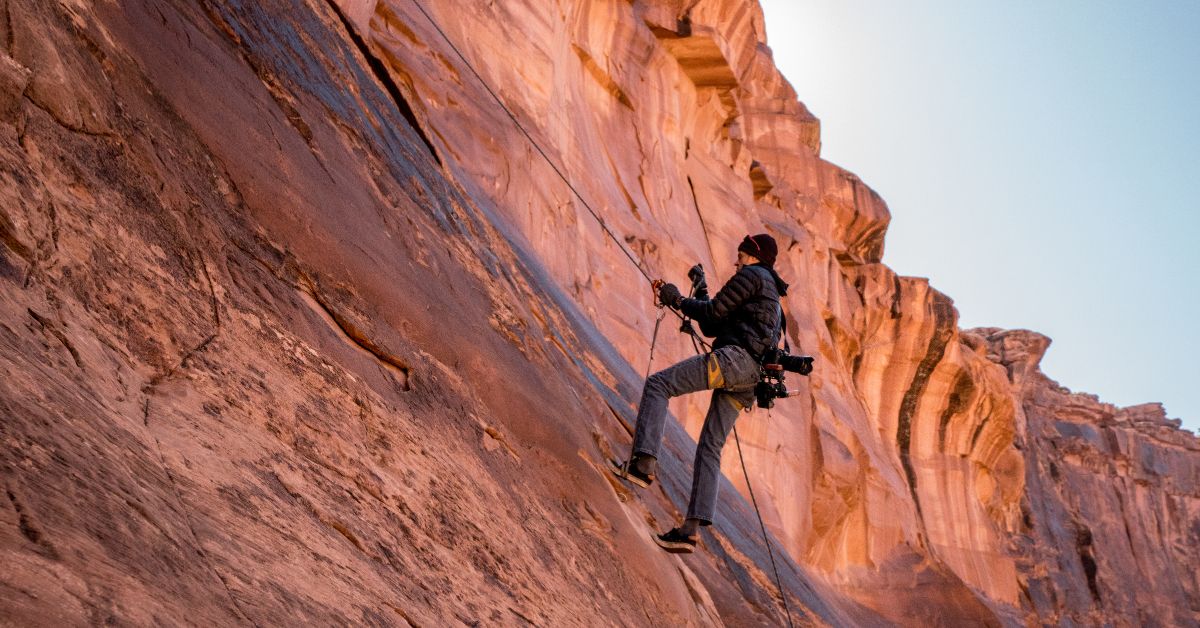4-Day Photographer Itinerary for Moab, Utah
A photographer itinerary for Moab is the best thing to look for if you’re trying to explore different shots and angles of Moab’s beauty.
Moab is a paradise for photographers, offering dramatic red-rock landscapes, natural arches, and stunning light from sunrise to sunset. This 4-day itinerary will guide you through Arches and Canyonlands National Parks (and beyond) to capture iconic shots. We’ll also cover practical tips on gear, timing, and permits to ensure you’re prepared for each shoot.
Table of Contents
Essential Gear & Tips
Before you head out on your Moab photography adventure, make sure you’re equipped with the right tools to maximize your shooting opportunities and handle the unique conditions of the desert landscape. Here’s a checklist of must-have gear and shooting strategies to help you succeed:
- Bring a wide-angle lens to capture Moab’s expansive vistas.
- Use a sturdy tripod for sharp images in low light.
- Pack neutral density filters for creative long exposures.
- Include a polarizing filter to reduce glare in harsh sunlight.
- Plan your shoots during the golden hours – sunrise and sunset – when the red rocks glow with intense color.
- Avoid shooting during midday light (10am–3pm) unless clouds add interest. Use this time for scouting, resting, or traveling.
- Bring a headlamp for predawn hikes and night photography.
- Carry plenty of water and snacks to stay energized during long outdoor sessions.
Note: If visiting in peak season, be aware that Arches National Park requires a timed-entry reservation between 7am and 4pm (April through October). You can avoid this by entering before 7am for sunrise or after 4pm for late-day shoots. Also, standard park entry fees apply; no special photography permit is needed for personal use.
Day 1: Arches National Park – Sunrise to Sunset Highlights
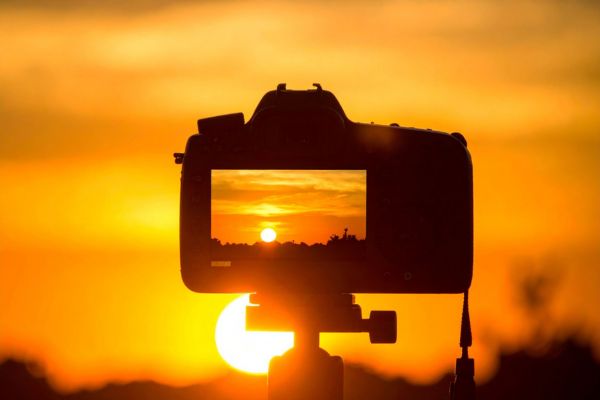
Sunrise at the Windows Section: Begin in Arches National Park at the Windows Section. At first light, the sandstone fins and arches are bathed in soft, warm hues. Turret Arch and the North Window are especially stunning in early morning. These formations face the rising sun and are best photographed at sunrise. Set up your tripod and be patient as the sun peeks over the horizon.
Midday in Arches – Exploring and Scouting: Explore Devils Garden or Landscape Arch around midday. Use this time to scout compositions or take a break. Midday light is harsh, but a bit of cloud cover can improve photos.
Sunset at Delicate Arch: Hike to Delicate Arch in the late afternoon (3.2-mile round trip). At golden hour, the arch glows deep orange-red. Get there early to claim a good spot and use the La Sal Mountains as a backdrop. Stay until the sky begins to fade and bring a headlamp for the return hike.
Day 2: Canyonlands & Dead Horse Point
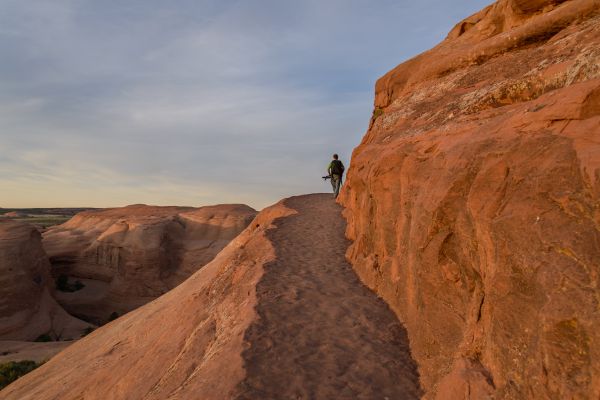
Sunrise at Mesa Arch: Head to Canyonlands (Island in the Sky district) to photograph Mesa Arch at sunrise. The arch glows brilliant orange as the first rays hit it. Arrive early to secure a spot and frame the sunburst through the arch with Buck Canyon and La Sal Mountains beyond.
Morning in Canyonlands: Visit Grand View Point and Green River Overlook while the light is still soft. Take a break during harsh midday light.
Afternoon at Dead Horse Point: Drive to Dead Horse Point State Park and explore overlooks. The view of the Colorado River’s gooseneck bend is iconic.
Sunset at Dead Horse Point: Set up for golden hour at the main overlook. As the sun sets, the red cliffs ignite in vivid hues. Stay for the pastel afterglow and possibly some stargazing in this designated Dark Sky Park.
Day 3: Colorado River Gorge & Fisher Towers
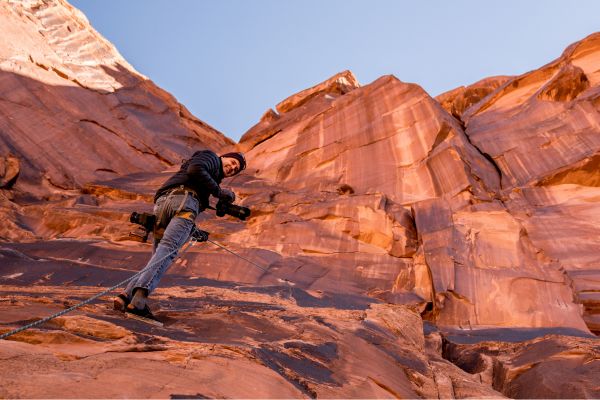
Morning Options: Optional sunrise shoot in Castle Valley or rest in Moab. If photographing Castleton Tower, early morning is best.
Scenic Byway 128: Drive Highway 128 along the Colorado River. Great for midday scouting and casual shooting.
Fisher Towers at Golden Hour: Arrive mid-afternoon at Fisher Towers. Hike part of the 2.2-mile trail or photograph from the parking area. At golden hour, the red-orange rock glows richly. Sunset here is especially photogenic.
Astrophotography: Head to Arches National Park after dark to photograph the Milky Way. Use locations like Double Arch or Balanced Rock. Bring a fast wide-angle lens, high ISO, and a tripod. Consider light painting or silhouette compositions.
Day 4: Bonus Shots and Farewell to Moab
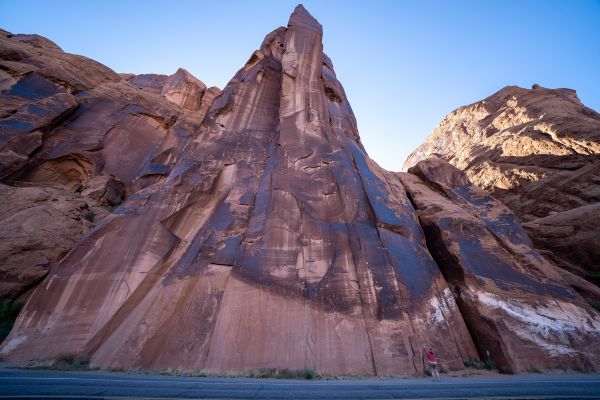
Sunrise Options: Return to Mesa Arch or Dead Horse Point for a final sunrise. Morning light often yields clear, crisp photos with fewer crowds.
Moab Town & La Sal Loop: Spend the morning exploring downtown Moab for cultural shots or drive the La Sal Mountain Loop Road for elevated views.
Sunset Finale: Return to Arches for a final golden hour session. Balanced Rock and the Windows glow in late light. Finish your trip with one last breathtaking photo.
Start Your Moab Photo Adventure Today
Moab truly lives up to its reputation as a photographer’s playground. From the fiery sunrise at Mesa Arch to the golden glow of Fisher Towers and the starry skies above Arches, this 4-day itinerary helps you capture it all.
Be flexible, chase the light, and most importantly, enjoy every moment.
Photographer Itinerary for Moab FAQs
What is the best time of year for photographers to visit Moab?
The best time to visit Moab for photography is spring (April–May) and fall (September–October) when temperatures are comfortable and lighting conditions are ideal. These months offer crisp air, dramatic skies, and fewer crowds, making sunrise and sunset photography especially rewarding.
Where can I photograph the Milky Way in Moab?
Some of the best Milky Way photography locations in Moab include Arches National Park (Double Arch, Balanced Rock, and the Windows Section), Dead Horse Point State Park, and Fisher Towers. For the clearest results, plan your shoot on a moonless night and use a sturdy tripod with a wide-aperture lens.
What are the best sunrise and sunset photography spots in Moab?
Top sunrise spots include Mesa Arch in Canyonlands and the Windows Section in Arches National Park. For sunset, head to Delicate Arch, Dead Horse Point State Park, or Fisher Towers, where golden hour light sets the red rock formations aglow.

